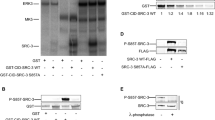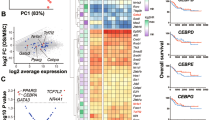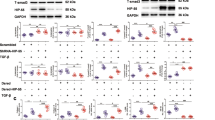Abstract
The three related 160-kDa proteins, SRC-1, TIF-2 and RAC-3, were initially identified as factors interacting with nuclear receptors. They have also been reported to potentiate the activity of other transcription factors such as AP-1 or NF-κB. The aim of this work was to identify whether SRC-1 interferes with the TGF-β/Smad signaling pathway, and if so, to identify its underlying mechanisms of action. Using transient cell transfection experiments performed in human dermal fibroblasts with the Smad3/4-specific (SBE)4-lux reporter construct, as well as the human PAI-1 promoter, we determined that SRC-1 enhances TGF-β-induced, Smad-mediated, transcription. Likewise, SRC-1 overexpression potentiated TGF-β-induced upregulation of PAI-1 steady-state mRNA levels. Using a mammalian two-hybrid system, we demonstrated that SRC-1 interacts with the transcriptional co-activators p300/CBP, but not with Smad3. Overexpression of the adenovirus E1A oncoprotein, an inhibitor of CBP/p300 activity, prevented the enhancing effect of SRC-1 on Smad3/4-mediated transcription, indicating that p300/CBP may be required for SRC-1 effect. Such hypothesis was validated, as expression of a mutant form of SRC-1 lacking the CBP/p300-binding site failed to upregulate Smad3/4-dependent transcription, while full-length SRC-1 potentiated p300·Smad3 interactions. These results identify SRC-1 as a novel Smad3/4 transcriptional partner, facilitating the functional link between Smad3 and p300/CBP.
This is a preview of subscription content, access via your institution
Access options
Subscribe to this journal
Receive 50 print issues and online access
$259.00 per year
only $5.18 per issue
Buy this article
- Purchase on Springer Link
- Instant access to full article PDF
Prices may be subject to local taxes which are calculated during checkout







Similar content being viewed by others
References
Andrews NC and Faller DV . (1991). Nucleic Acids Res., 19, 2499.
Anzick SL, Kononen J, Walker RL, Azorsa DO, Tanner MM, Guan XY, Sauter G, Kallioniemi OP, Trent JM and Meltzer PS . (1997). Science, 277, 965–968.
Arany Z, Newsome D, Oldread E, Livingston DM and Eckner R . (1995). Nature, 374, 81–84.
Atfi A, Buisine M, Mazars A and Gespach C . (1997). J. Biol. Chem., 272, 24731–24734.
Attisano L and Wrana JL . (2002). Science, 296, 1646–1647.
Bautista S, Valles H, Walker RL, Anzick S, Zeillinger R, Meltzer P and Theillet C . (1998). Clin. Cancer Res., 4, 2925–2929.
Berns EM, van Staveren IL, Klijn JG and Foekens JA . (1998). Breast Cancer Res. Treat., 48, 87–92.
Bouras T, Southey MC and Venter DJ . (2001). Cancer Res., 61, 903–907.
Carrero P, Okamoto K, Coumailleau P, O'Brien S, Tanaka H and Poellinger L . (2000). Mol. Cell Biol., 20, 402–415.
Chauchereau A, Georgiakaki M, Perrin-Wolff M, Milgrom E and Loosfelt HJ . (2000). J. Biol. Chem., 275, 8540–8548.
Cottone E, Orso F, Biglia N, Sismondi P and de Bortoli M . (2001). Int. J. Biol. Markers, 16, 151–166.
deCaestecker MP, Parks WT, Frank CJ, Castagnino P, Bottaro DP, Roberts AB and Lechleider RJ . (1998). Genes Dev., 12, 1587–1592.
de Caestecker MP, Yahata T, Wang D, Parks WT, Huang S, Hill CS, Shioda T, Roberts AB and Lechleider RJ . (2000). J. Biol. Chem., 275, 2115–2122.
Dennler S, Itoh S, Vivien D, ten Dijke P, Huet S and Gauthier JM . (1998). EMBO J., 17, 3091–30100.
Derynck R, Akhurst RJ and Balmain A . (2001). Nat. Genet., 29, 117–129.
Derynck R and Zhang YE . (2003). Nature, 425, 577–584.
Feng XH, Zhang Y, Wu RY and Derynck R . (1998). Genes Dev., 12, 2153–2163.
Ghadimi BM, Schrock E, Walker RL, Wangsa D, Jauho A, Meltzer PS and Ried T . (1999). Am. J. Pathol., 154, 525–536.
Glass CK and Rosenfeld MG . (2000). Genes Dev., 14, 121–141.
Guan XY, Xu J, Anzick SL, Zhang H, Trent JM and Meltzer PS . (1996). Cancer Res., 56, 3446–3450.
Janknecht R, Wells NJ and Hunter T . (1998). Genes Dev., 12, 2114–2119.
Keeton MR, Curriden SA, van Zonneveld AJ and Loskutoff DJ . (1991). J. Biol. Chem., 266, 23048–23052.
Kim HJ, Kim JH and Lee JW . (1998). J. Biol. Chem., 273, 28564–28567.
Kraus VB, Moram E and Neirns JR . (1992). Mol. Cell Biol., 12, 4391–4399.
Lee SK, Kim HJ, Na SY, Kim TS, Choi HS, Im SY and Lee JW . (1998). J. Biol. Chem., 273, 16651–16654.
Lee SK, Kim HJ, Kim JW and Lee JW . (1999). Mol Endocrinol., 13, 1924–1933.
Li H, Gomes PJ and Chen JD . (1997). Proc. Natl. Acad. Sci. USA, 94, 8479–8484.
List HJ, Reiter R, Singh B, Wellstein A and Riegel AT . (2001). Breast Cancer Res. Treat., 68, 21–28.
Liu F, Hata A, Baker JC, Doody J, Carcamo J, Harland RM and Massague J . (1996). Nature, 381, 620–623.
Massagué J and Chen YG . (2000). Genes Dev., 14, 627–644.
Massagué J and Weis-Garcia F . (1996). Cancer Surv., 27, 41–64.
McKenna NJ, Lanz RB and O'Malley BW . (1999). Endocr. Rev., 20, 321–344.
Na SY, Lee SK, Han SJ, Choi HS, Im SY and Lee JW . (1998). J. Biol. Chem., 273, 10831–10834.
Onate SA, Tsai SY, Tsai MJ and O'Malley BW . (1995). Science, 270, 1354–1357.
Pouponnot C, Jayaraman L and Massague J . (1998). J. Biol. Chem., 273, 22865–22868.
Powell SM, Christiaens V, Voulgaraki D, Waxman J, Claessens F and Bevan CL . (2004). Endocr. Relat. Cancer, 11, 117–130.
Sakakura C, Hagiwara A, Yasuoka R, Fujita Y, Nakanishi M, Masuda K, Kimura A, Nakamura Y, Inazawa J, Abe T and Yamagishi H . (2000). Int. J. Cancer, 89, 217–223.
Shen X, Hu PP, Liberati NT, Datto MB, Frederick JP and Wang XF . (1998). Mol. Biol. Cell., 9, 3309–3319.
Shi Y, Hata A, Lo RS, Massague J and Pavletich NP . (1997). Nature, 388, 87–93.
Shi Y and Massagué J . (2003). Cell, 113, 685–700.
Snowden AW and Perkins ND . (1998). Biochem. Pharmacol., 55, 1947–1954.
Topper JN, DiChiara MR, Brown JD, Williams AJ, Falb D, Collins T and Gimbrone Jr MA . (1998). Proc. Natl. Acad. Sci. USA, 95, 9506–9511.
Voegel JJ, Heine MJ, Zechel C, Chambon P and Gronemeyer H . (1996). EMBO J., 15, 3667–3675.
Wakefield LM and Roberts AB . (2002). Curr. Opin. Genet. Dev., 12, 22–29.
Workman JL and Kingston RE . (1998). Annu. Rev. Biochem., 67, 545–579.
Yanagisawa J, Yanagi Y, Masuhiro Y, Suzawa M, Watanabe M, Kashiwagi K, Toriyabe T, Kawabata M, Miyazono K and Kato SC . (1999). Science, 283, 1317–1321.
Yuan W, Condorelli G, Caruso M, Felsani A and Giordano A . (1996). J. Biol. Chem., 271, 9009–9013.
Zawel L, Dai JL, Buckhaults P, Zhou S, Kinzler KW, Vogelstein B and Kern SE . (1998). Mol. Cell, 1, 611–617.
Author information
Authors and Affiliations
Corresponding author
Rights and permissions
About this article
Cite this article
Dennler, S., Pendaries, V., Tacheau, C. et al. The steroid receptor co-activator-1 (SRC-1) potentiates TGF-β/Smad signaling: role of p300/CBP. Oncogene 24, 1936–1945 (2005). https://doi.org/10.1038/sj.onc.1208343
Received:
Revised:
Accepted:
Published:
Issue Date:
DOI: https://doi.org/10.1038/sj.onc.1208343
Keywords
This article is cited by
-
CISD2 promotes lung squamous carcinoma cell migration and invasion via the TGF-β1-induced Smad2/3 signaling pathway
Clinical and Translational Oncology (2023)
-
The TGF-β/SMAD pathway is an important mechanism for NK cell immune evasion in childhood B-acute lymphoblastic leukemia
Leukemia (2016)
-
The role of mitogen-activated protein kinases and sterol receptor coactivator-1 in TGF-β-regulated expression of genes implicated in macrophage cholesterol uptake
Scientific Reports (2016)
-
Loss of steroid receptor co-activator-3 attenuates carbon tetrachloride-induced murine hepatic injury and fibrosis
Laboratory Investigation (2009)
-
Estrogen receptors inhibit Smad3 transcriptional activity through Ap-1 transcription factors
Molecular and Cellular Biochemistry (2007)



